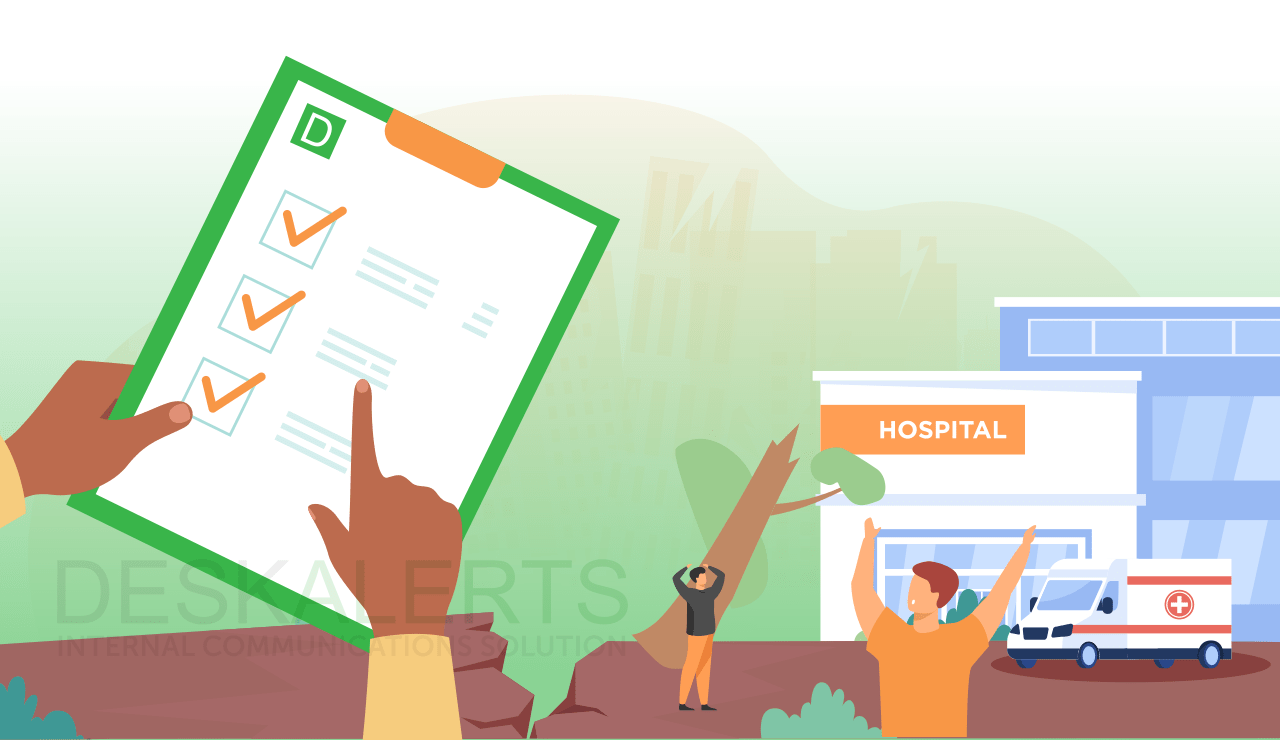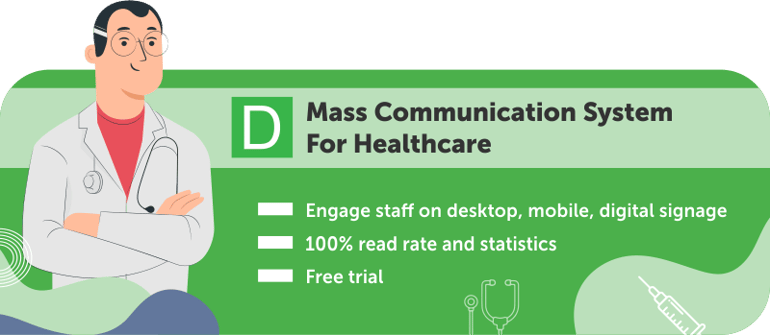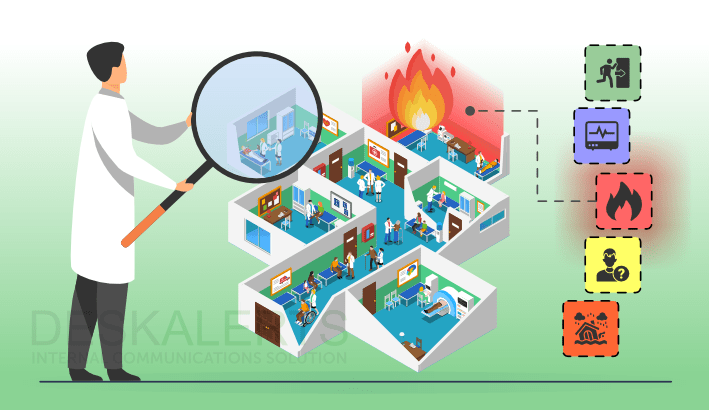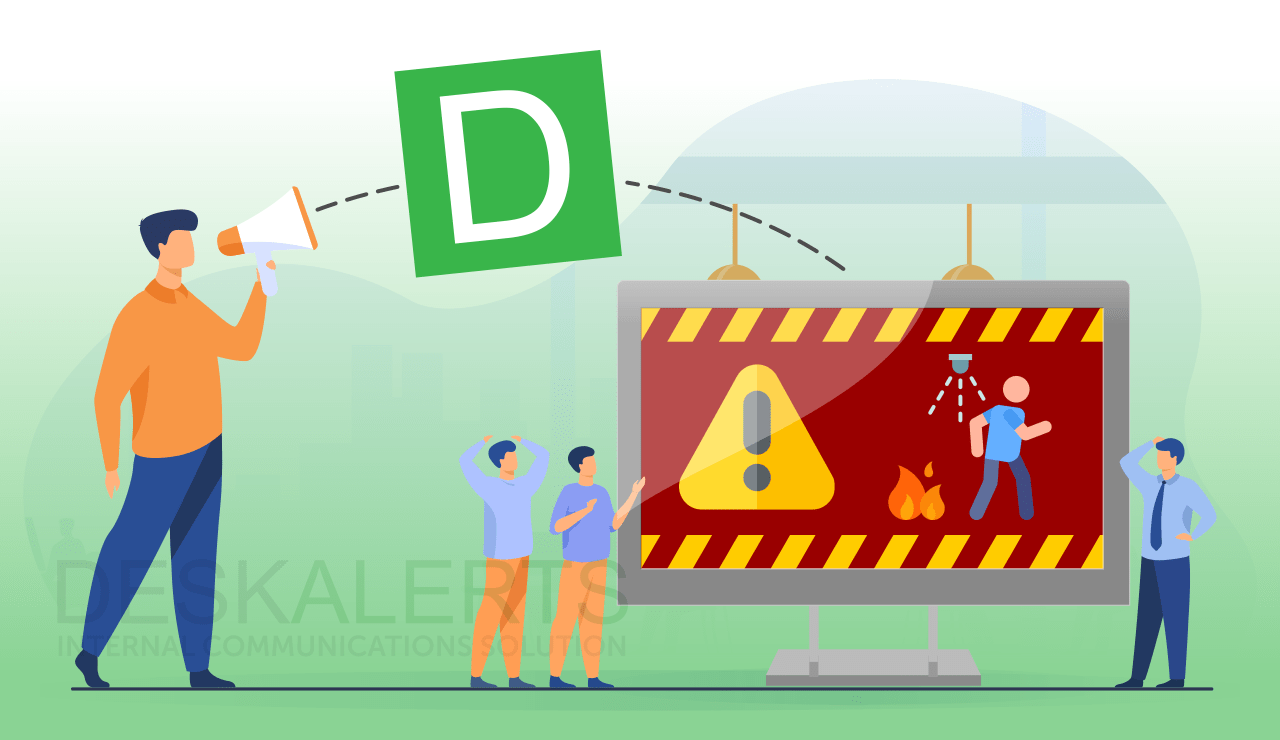 Emergencies can strike at any time. Whether it’s a natural disaster like an earthquake, hurricane, flood, or tornado, or if it’s a man-made disaster like terrorism or an active shooter, you never know what could be around the corner.
Emergencies can strike at any time. Whether it’s a natural disaster like an earthquake, hurricane, flood, or tornado, or if it’s a man-made disaster like terrorism or an active shooter, you never know what could be around the corner.
You obviously can’t rely on a crystal ball to predict when most emergency situations are going to take place, but the next best thing is being prepared for a range of different scenarios.
Table of contents
Top emergency management tips in healthcare
The role of healthcare executives in emergency management
The types of emergencies healthcare organizations should prepare for
Hospital emergency preparedness checklist
DeskAlerts for hospital emergency preparedness
Top emergency management tips in healthcare
For those working in hospitals and healthcare, emergencies can affect them in different ways to those who work in other kinds of organizations. These types of organizations often find themselves at the center of an emergency situation, especially when there is one with mass casualties seeking urgent medical attention.
Preparing for an emergency in the healthcare sector requires planning for both the surge in patients seeking medical attention, as well as what to do to protect staff and existing patients who can find themselves in the midst of a disaster. There’s also an important role to play in helping the community to recover from the disaster as well.
These are our top tips for healthcare emergency preparedness:
1. Have written plans in place
Your organization should undertake hazard and risk assessments to determine the disasters that are most likely to take place in your geographic area that would negatively impact on patients and staff.
Emergency plans should be prepared for this entire range of scenarios that could affect your organization, ensuring you specify how you will utilize resources and employees in your response.
2. Train your staff well
Your plans aren’t worth the paper they are written on if your employees don’t know how to implement and follow them when faced with a real-life emergency event.
It’s essential that you train your staff in the role that they are expected to play in the event of an emergency situation. Run drills and other role-playing scenarios to assist them in getting practical hands-on experience enacting an emergency event so they aren’t thrown in at the deep end when an emergency occurs for real.
How to Deliver Training to Your Employees
3. Regularly review your protocols
Emergency preparedness in the healthcare sector isn’t something you can just set and forget. Rather, you need to constantly review plans and make adjustments to ensure that your staff and facilities are best-placed to handle an emergency when it occurs.
4. Invest in a good communications system
Reliable communication is one of the most important aspects of emergency preparedness in healthcare organizations. Not only is it important so that vital information is shared with the right people in a timely manner so they can respond, but it is also important to contain the message and stop the spread of misinformation.
Investing in a dedicated emergency communications channel like DeskAlerts is a great way to ensure that your employees are kept informed in the event of a disaster. This system allows you to send pop-up notifications to every computer in your organization at the press of a button, ensuring vital information is shared with as many people as quickly.
See How Real Hospitals Prepare for Emergencies with Better Communication
Download our free guide 8 Real-World Use Cases: How Healthcare Teams Communicate Faster and Safer with DeskAlerts.
Discover how leading hospitals:
- Communicate instantly across departments
- Alert staff in real time during a crisis
- Improve emergency response and accountability
- Coordinate leadership and frontline teams effectively

5. Ensure your organization is adequately resourced
Your hospital emergency preparedness planning and training are nothing if you don’t have appropriate resources to deploy in the event of an emergency situation. It’s critical that you have resources in place for a range of different needs and scenarios so that you can respond to any type of situation that your organization may face.
The role of healthcare executives in emergency management
Executives in healthcare organizations have a very important role to play in being prepared for and responding to emergency issues that affect their organizations. They are ultimately responsible for the protection of employees and patients alike, preventing them from being exposed to risks.
Leadership is important in any critical situation, and CEOs and other senior managers should be ready to lead efforts to guide employees through an emergency.
They can also help to lead the community through a crisis, such as a pandemic, and provide appropriate advice to reduce the risk of infection and disease spreading.
The types of emergencies healthcare organizations should prepare for
When it comes to emergency situations, hospitals and healthcare organizations should be prepared to deal with the following:
- Chemical emergencies
- Biological and chemical agents
- Natural disasters
- Severe weather events
- Radiation emergencies
- Fire
- Terrorism
- Disasters that have mass casualties
- Civil unrest
- Power outages
- Disease outbreaks, including influenza, Ebola, COVID-19, SARS
- Heat waves.
These can be emergency situations that directly affect the hospital and healthcare facilities and/or are taking place in the community and will, therefore, put a strain on the hospital’s resources. It’s important to be prepared for both types of scenarios.
Hospital emergency preparedness checklist
When hospitals and healthcare facilities are unprepared to deal with emergency situations, it can make a dangerous situation even more precarious. Events in living memory, such as the Hurricane Katrina disaster, paint a picture of what can go wrong when unprepared facilities become overwhelmed.
The World Health Organization recommends that the following are included in emergency preparedness checklists in healthcare organizations:
- Appoint people to be in charge of incident command, including planning, logistics, operations, finance, and administration.
- Have systems in place to ensure that safety and security measures are implemented when there is an emergency.
- Ensure you have communications systems, processes and personnel ready to go.
- Maintain continuity of services despite the emergency incident.
- Have excellent mass casualty triage protocols in place to meet the demands of the disaster.
- Be prepared for surge capacity.
- Manage supply chains and logistics to ensure the ongoing availability of crucial supplies.
- Ensure you have adequate staff capacity.
- Post-disaster recovery plans to get things back to normal quickly after the disaster.
What makes a successful emergency plan in healthcare?
While there isn’t a one-size-fits-all plan that all hospital and healthcare facilities can use to successfully implement emergency protocols, there are some best practices that will suit most institutions and should be included in response plans.
- Communication
- Training
- Drills and scenario rehearsals
- Evaluations
Your comprehensive solution for hospital emergency preparedness
DeskAlerts is an internal communications software system that is a valuable asset for many hospital and healthcare institutions around the world who use this hospital notification system both for day-to-day communications and for communicating in emergency situations.
With DeskAlerts, you can quickly inform your entire workforce about critical situations in a matter of seconds. Alerts are sent to computer screens in the hospital, digital screens, and to mobile and tablet devices.
A range of different tools and channels are available so that you can push important information out to employees in different ways, ensuring that they will see the information you need them to see.
This can include:
You can send notifications using text, graphics or video. The system can be used during drills before an emergency as well as during one.
See How Hospitals Use DeskAlerts in Real Emergencies
You’ve seen how DeskAlerts supports hospital emergency preparedness. Now explore real examples of how leading healthcare organizations use it to improve response times, coordination, and patient safety.
Download our free guide 8 Real-World Use Cases: How Healthcare Teams Communicate Faster and Safer with DeskAlerts.
You’ll discover how hospitals:
- Alert staff during code situations in seconds
- Reach remote and shift-based teams reliably
- Cut through noise with critical notifications
- Improve readiness and reduce risk across departments

Frequently Asked Questions
What are the best tips for emergency management?
The top tips for healthcare emergency management include:
- Ensuring there are emergency supplies available
- Carrying out practice drills in advance
- Understanding how to shut off gas, water, electricity etc in a disaster
- Having evacuation procedures in place.
What are the 5 categories of emergency preparedness and response?
The five categories of emergency preparedness and response are:
- Prevention
- Protection
- Mitigation
- Response
- Recovery
What is healthcare emergency management?
Healthcare emergency management refers to the development and implementation of plans and procedures when a hospital or healthcare organization is affected by a major emergency or disaster.
 Caroline Duncan
Caroline Duncan
 Emergencies can strike at any time. Whether it’s a natural disaster like an earthquake, hurricane, flood, or tornado, or if it’s a man-made disaster like terrorism or an active shooter, you never know what could be around the corner.
Emergencies can strike at any time. Whether it’s a natural disaster like an earthquake, hurricane, flood, or tornado, or if it’s a man-made disaster like terrorism or an active shooter, you never know what could be around the corner.







